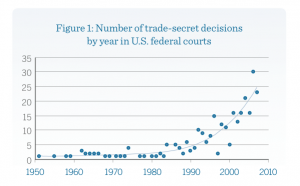Federal Circuit Weighs In on Step One of Two-Step Inter Partes Review Procedure
By admin on July 28, 2014
Leave a comment
In St. Jude Medical, Cardiology Div. v. Volcano Corp., 749 F.3d 1373, 110 U.S.P.Q.2D (BNA) 1777 (Fed. Cir. Apr. 24, 2014), the Federal Circuit, almost predictably, declined to consider a denied petition to institute an inter partes review (IPR) filed by St. Jude Medical. In rendering its decision, the Federal Circuit followed the language of 35 U.S.C. § 314(d), which states that “[t]he determination by the Director whether to institute an inter partes review under this section shall be final and nonappealable.”
While Section 314(d) might have been the only reasoning needed to decide the case, the Federal Circuit included additional discussion regarding the two-step nature of IPRs: step one comprising the U.S. Patent and Trademark Office Director’s decision whether to institute the IPR; and step two comprising a decision under § 318(a) by the Patent and Trial Appeal Board regarding patentability after conducting the IPR proceeding (i.e., a final written decision). See, e.g., Belkin Int’l, Inc. v. Kappos, 696 F.3d 1379, 104 U.S.P.Q.2D (BNA) 1348 (Fed. Cir. 2012). (It may be noteworthy that Belkin involved an inter partes re-examination, yet the Federal Circuit used this case as the basis for the two-step nature of IPR.)
Under 35 U.S.C. § 319, the Board’s decision under § 318(a) (i.e., after the Director’s decision and the IPR is in motion) is appealable. It appears that the Federal Circuit included this discussion to highlight its view that the Director’s decision whether to institute an IPR is not considered to be a “final written decision” of the Board under § 318(a). Moreover, to clear up any confusion, the court observed that 28 U.S.C. § 1295(a)(4)(A) (jurisdiction of the Federal Circuit after appeal from, inter alia, IPR) did not provide jurisdiction to review the Director’s decision. Rather, § 1295(a)(4)(A), similar to 35 U.S.C. § 319, refers to final Board decisions under 35 U.S.C. § 318(a), according to the court.
The court was careful to point out that its decision followed the Director’s decision regarding a formality issue of a late IPR petition, but would likely apply to all decisions of the Director on whether to institute an IPR.
Interestingly, on the same day, the Federal Circuit also denied petitions for mandamus related to the Director’s decisions regarding IPR requests by two different parties – Dominion Dealer Solutions, and Procter & Gamble Co. Dominion sought review of the Director’s decision not to institute several of its IPR requests. See In re Dominion Dealer Solutions, LLC, 749 F.3d 1379, 110 U.S.P.Q.2D (BNA) 1780 (Fed. Cir. Apr. 24, 2014). Conversely, Procter & Gamble, as patent owner, sought mandamus for review of the Director’s decision to institute an IPR request. See In re Procter & Gamble Co., 749 F.3d 1376, 110 U.S.P.Q.2D (BNA) 1782 (Fed. Cir. Apr. 24, 2014). In its denial of mandamus of these cases, the Federal Circuit cited similar reasoning as was set forth in the St. Jude Medical decision. It is noteworthy that Dominion Dealer Solutions had concurrently sought review of the Director’s decision not to institute an IPR in the Eastern District of Virginia in addition to its mandamus petitions. See Dominion Dealer Solutions, LLC v. Lee, 2014 U.S. Dist. LEXIS 54350 (E.D. Va. April 18, 2014). This District Court action failed as well.
In light of the St. Jude Medical decision, it is important to ensure that IPR petitions are timely filed, complete and accurate, and meet § 314(a) subject matter threshold limitations (i.e., “a reasonable likelihood” of prevailing on at least one of the challenged claims). A variety of guidance is available on threshold issues in the form of representative Board decisions to institute IPR proceedings, though detailed discussion of this guidance is beyond the scope of this article. See, e.g., Microsoft Corp. v. Proxyconn, Inc., IPR2012-00026 Decision to Institute, Paper 17, Dec. 21, 2012; Garmin Int’l, Inc. v. Cuozzo Speed Techs LLC, IPR2012-00001 Decision to Institute, Paper 15, Jan. 9, 2013; Microstrategy, Inc. v. Zillow, Inc., IPR2013-00034 Decision to Institute, Paper 22, Apr. 22, 2013.
St. Jude Medical carries special significance for parties currently accused of infringing a patent in a District Court that are deciding whether to file an IPR request. In particular, 35 U.S.C. § 315(b) prohibits IPR requests beyond one year after an infringement complaint, including counterclaims alleging infringement. See St. Jude Medical, Cardiology Division, Inc. v. Volcano Corp., IPR2013-00258 (PTAB 2013); Accord Healthcare v. Eli Lilly and Co., IPR2013-00356 (PTAB 2013). Passing beyond that one-year threshold is a basis for the Director denying the institution of an IPR; which decision is unappealable.
Accordingly, if you are approaching the § 315(b) deadline for filing an IPR petition, you should carefully craft your petition so that it meets the § 314(a) threshold, and it isn’t determined to be defective due to informalities. In certain cases a defective petition can be fixed to address formalities, while the filing date of the original petition is accorded. See, e.g., Macauto U.S.A. v. Baumeister & Ostler GmbH & Co., IPR2012-00004, Notice of Defective Petition, Paper 6, Sept. 21, 2012. In other situations, where the defect may affect the substance of the petition, a new petition filing date may be accorded when the defect is corrected. See Ariosa Diagnostics v. Isis Innovation Ltd., IPR2012-00022, Notice of Incomplete Petition, Paper 5, Sept. 27, 2012 (requiring correction of Exhibits).

